T he L o op


THE JOURNAL OF FLY CASTING PROFESSIONALS

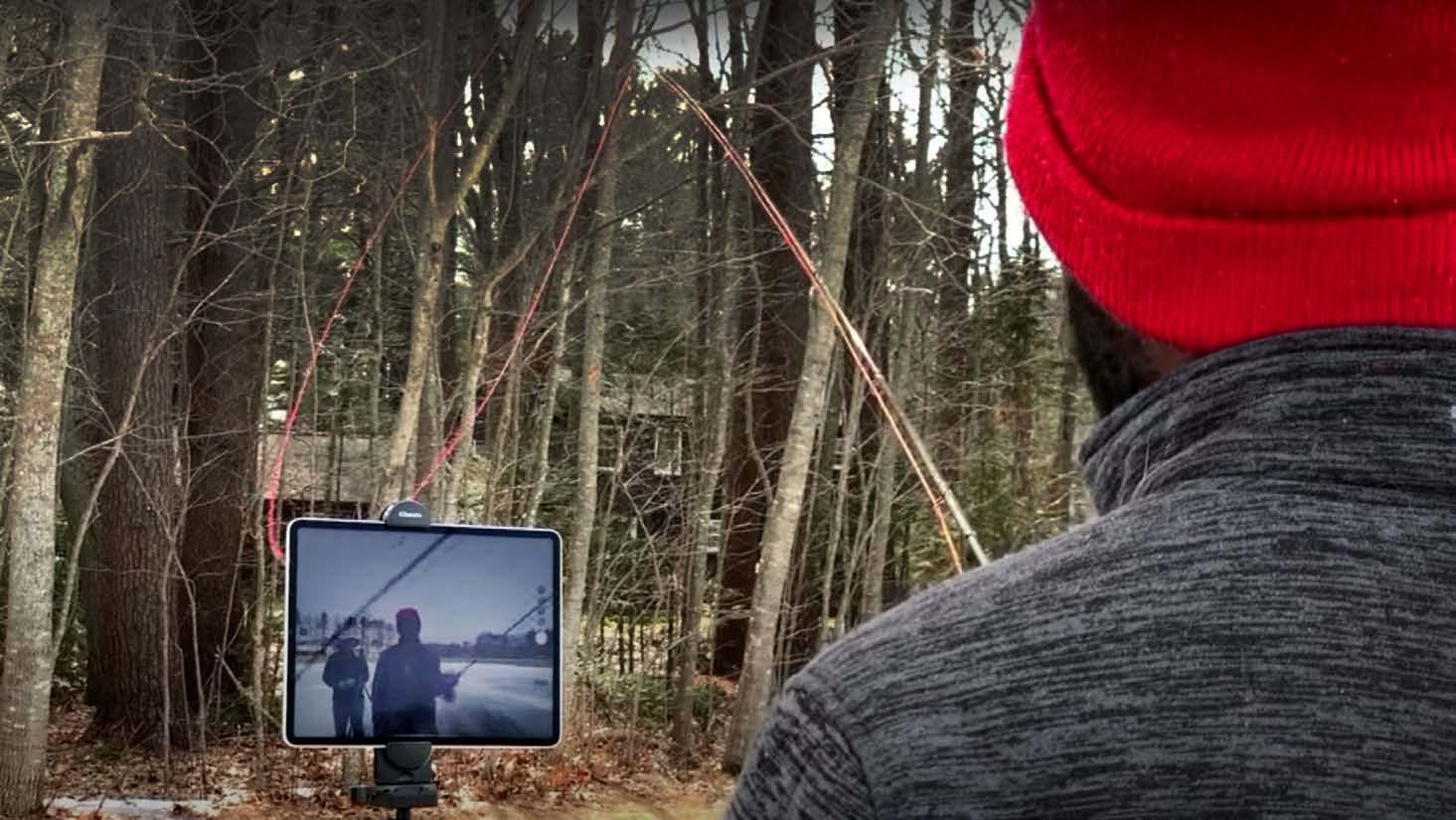
In this issue:
• Use Your Tablet Computer as a Casting Mirror by Macauly Lord
• How Leaders Work by Bruce Richards
• Grip by Chris King ... and more
Editorial
I am enjoying today’s sunny weather. Fortunately, we have not had many sunny days this winter in northern California. Seemingly continuous atmospheric rivers have delivered copious rain and snow. Snowpack levels are among the highest ever observed. Reservoirs are filled nearly to capacity, and rivers are running high. This all bodes well for the coming summer. We are hopeful for a kinder and gentler fire season and sustained flows to support freshwater and anadromous fish. The news is not all good, however. Sacramento River and Klamath River king salmon runs are predicted to be dangerously low because of multiple years of extreme drought. Several years of near-normal precipitation and favorable ocean conditions will be needed to help kings and other anadromous fish to rebound.
The fish populations that we value as fly fishers are subject to the influence of climate variability (the America West in general, and California in particular, historically experience wide climatic swings), climate change, and myriad human activities. Hopefully, we are prepared to advocate for strong conservation approaches amid these climatic stressors to streams, rivers, lakes, and oceans no matter what part of the globe we call home.
On a more pragmatic note, I am very pleased with the spring issue of The Loop. There are enlightening articles dealing with casting principles and instruction. Also, it is my pleasure to introduce our Audrey Wilson as our new associate editor.
Jim Wigington - Editor in ChiefWANTED
We’re calling for article ideas from all CICP members, all casting instructors, and all fly fishing photographers worldwide.
Please email your ideas and photos to: loop@flyfishersinternational.org

Use Your Tablet Computer as a Casting Mirror
By Macauley LordOver thirty-seven years, two leaps of technology have revolutionized my students’ success. The first was using a pocket video camera—my cell phone— to record-and-replay their casting. The changes that would result were often remarkable. Students would react to seeing their own casting with comments like, “Oh my God!” or “I had no idea I was doing that.” Soon after, I was filming all my students with my tablet (because of its much-bigger screen size than my phone.)
But something even better has come along: using the tablet as a mirror, so the student sees her casting while she’s casting In Real Time.
History and Rationale: The idea came years ago from Joan Wulff. The dance studio that she owned as a young woman had lots of mirrors. So, she knew that dancing – and casting – while watching oneself in a mirror could be transformative. Joan’s students at the Wulff School still use one, as do gymnasts, golfers and today’s ballerinas.

Why? Because our students, like all of us, have flawed proprioception – their sense of their body’s movement, action, and location. So, hand them a fly rod, and give them our very best instruction, and most
of our students will move the rod too ___, or too ___, or not ___ enough. That’s why they need us.
The tablet/mirror lets them see themselves as they otherwise cannot, from the outside, just as we see them.
THE LOOP, SPRING 2023
Tablet Computer as a Casting Mirror
continued ...
Research shows that an external cue (like seeing oneself in the mirror) is usually superior to an internal one (like telling someone that they need to try to restrain some errant body motion.) Once you’ve given your students a visual and verbal image of how to make a good cast, showing them their real-time casting in the mirror will help them more than further words or concepts you might impart to them.
Typical results: Here’s one example of a teaching process with a beginner.
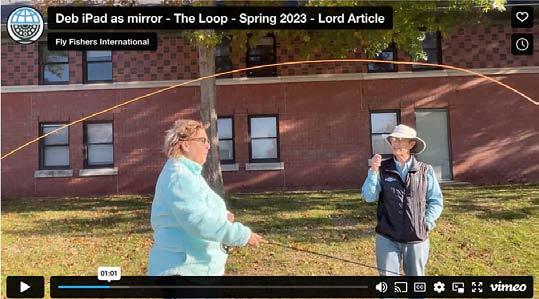
She’s already done some PULD’s, so she’s ready to try false-casting. You see her make common mistakes and you see my conventional responses to those. The remarkable part is that when she watches herself on the screen, she self-corrects. At the 3:42 minute mark, she sees herself on the screen as she rotates too far back, and she selfcorrects on the next stroke. At 4:16, she says, “I went back too far.” Again, she self-corrects on the next cast. Amazing!
Of course, some beginners can self-correct without the mirror, but that usually happens after they’ve already made at least a few dozen
good casts. The good casts she made on the screen were her very first good ones. In other words, the digital mirror gave her a dramatic jump-start over what my conventional instruction did for her.
Here are two other examples, one of Tony:
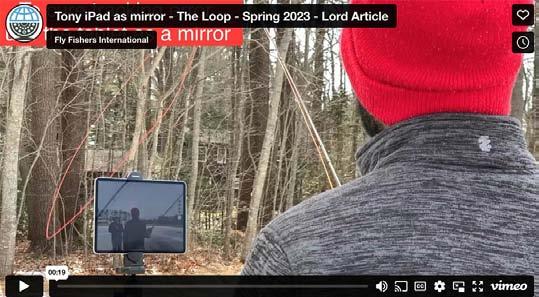
and one of Marc:

THE LOOP, SPRING 2023
Tablet Computer as a Casting Mirror continued ...
Teaching process: What would your teaching with a digital mirror look like?
1. Put your tablet (iPad/Galaxy/Surface Pro, etc.) on a clamp on a tripod.
2. Put it four feet away from the student for starters and adjust as needed.
3. Flip the screen and lens so your student can see themself casting.
4. Have them repeat as many of the casts as they can without fatiguing them. This is because you are not imbuing them with some kind of mental understanding. Instead, you are creating a new myelin sheath in them.
5. Once you think they might have found a bit of a groove—you could call it “muscle memory”—have them close their eyes as they make the motion, keeping their heads turned toward the tablet.
6. Once that seems to be working, have them turn their heads toward the front and then open their eyes. (I’m a fan of using the mirror with false casting over PULD or roll casting.)
It’s tempting to overly celebrate how good they will often be early on. Resist this: stay with the plan until you think you see a cast that’s repeatable without the tablet. This can take a few hundred casting strokes.
Is this better than using a motion-analysis app such as OnForm to record-and-replay your students? Wrong question: recording in OnForm lets you show much more of the cast to your student, like how their creep or drift results in subtle changes loop, casting distance or casting comfort.
Where mirroring shines brightest: If you wanted to teach students:
• where to stop the rod;
• where their hand-and-elbow should stop;
• how to refrain from tracking error (see photo of Tony in the red hat above);
• or how to add a micro-drift to refrain from creep; there is nothing like them seeing those things as they are doing them. They will self-correct in front of your eyes.
Another example is in hauling. Many of our novice haulers have a too-short or a too-early forward haul, or, most commonly, they fail to return their line hand to their rod hand during the backcast pause. Mirroring fixes these, instantly.
A humbling question: As I’ve watched my students fix their own errors while looking in the digital mirror, I’ve silently asked this: Do my students even need me now? Well, they still need to see my [usually] good casts, to know what good casts look like. They need me to tell them to start with the line out straight and the rod tip down, to lift the line slowly at first and speed up gradually to Jim Green’s “positive stop”, to pause for around one second; you know the rest. In other words, they still need me to explain and demonstrate good casting. Finally, they need me to guide them through enough repetitions of their good casts that their improvement is somewhat durable.
This kind of teaching is hardly even teaching. It is the antithesis of much the kind of teaching I’ve done for 37 years. After your official explain-and demonstrate, it requires no further explanation, no transfer of conceptual knowledge or principles, and virtually no appreciable mental effort by your students.
THE LOOP, SPRING 2023
Tablet Computer as a Casting Mirror continued ...
As such, it is deeply humbling, almost threatening to the instructor.
Try it now: I hope you’ll try it now, even if only in your dwelling with a pantomime. Then, try it with some students.
A very well-known instructor once observed that a distance-casting CI friend of mine was creeping. My friend asked, “What can I do to fix that?” The famous one answered, “Don’t creep.” The digital mirror is a better way.

Macauley Lord, MCI, received the Lifetime Achievement Award in Fly Casting Instruction from FFI in 2011.
He is an emeritus member of the Casting Board of Governors and a Level 2 Examiner.
He is the author of the L.L. Bean FlyCasting Handbook, (Lyons Press, 2007), and was the fly-casting columnist at American Angler for ten years. He has taught at the L.L. Bean Fly Fishing Schools since 1986 and was their Head Instructor or 12 years.
He was twice editor of The Loop and is the editor of the video that forms the foundation of the new CI Teaching Workshop. A seminary graduate and prison chaplain, he is at work on a book about people on the margins who find peace through fishing.
He thanks MCI Craig Buckbee for his help with this article.
Further reading:
1. Lord, 2018, “The Problem of Proprioception and the Cure of Paradoxical Intention” - p. 7.
www.flyfishersinternational.org/Portals/0/Documents/Casting/The%20 Loop/2017.DEC-2018.FEB.LOOP.pdf?ver=px1fQa5UpV6dEl6NPJNqEA%3 d%3d
2. Surtees, 2021, “Cues and Sensory Feedback” - p. 15.
www.flyfishersinternational.org/Portals/0/Documents/Casting/The%20 Loop/2021.NOV.LOOP.pdf?ver=fDIaMpbMy-4YOrmTYejXYQ%3d%3d
HOW TO ACCESS CONTINUING EDUCATION INSTRUCTOR RESOURCES
The author presented a FFI Casting Continuing Education program on this topic. Certified Instructors with the Casting Instructor Certification Program (CICP) can access a video recording of this program using the following instructions.
1. Login to your FFI account*
2. Select “Get Involved” tab and under
3. “Casting Instructor Certification” select “CICP Resources and CE”
4. Under “Instructor Resources-Continuing Education” select “CE Recordings”
5. Scroll down to the appropriate video and use the password above the video link(“CastingisAwesome!”)
*If you have not accessed the FFI website since the February 2023 update, click the “Reset Password” button before attempting to log-in.
GRIP
Chris King - Redding, CA
When we set out to diagnose casting faults, we often focus on power application, casting angle, timing and other common intricacies of the casting motion. Although an element of style as opposed to substance when it comes to the cast itself, let’s look at how a change in the grip on a fly rod can affect the common faults.
When I am looking at a student’s cast, I start by looking at the result - loop shape, trajectory, stability and so on. Then the question becomes: what did the rod do to form this loop? And then what did the caster do to make the rod do that?
The first connection between the caster and the rod is how they are actually holding the rod. I find that rod grip is often an overlooked aspect of helping students achieve a better casting result. Let’s discuss some of the common grips we see in fly casting and how they affect the cast.

Suitcase Grip

This grip is exactly like it sounds. Students grab the rod like a suitcase with their thumb overlapping their fingers and wave the stick back and forth. When we see how this affects control on the rod based on hand and arm positioning in the casting stroke, we see that this is a very poor grip for a fly cast. At the top of the casting stroke, after the backcast has been made, the rod angle will be almost horizontal often resulting in a back cast trajectory that is too low. This is often the student that continually ticks the water or catches their fly on the grass or brush behind them. On the forward cast, this grip lacks control, as there is no appendage extending up the rod handle to help with application of force or directionality. With your hand in a ball around the rod there is only one point of contact with the rod, and it tends to be loose and roll- around a bit in the hand. This is a poor grip on a fly rod and one that needs to be addressed.
THE LOOP, SPRING 2023
Grip continued ...
Thumb-on-Top Grip
Similar to the suitcase grip, with the thumbon-top grip you simply grab the rod and place your thumb opposite your fingers on the back or spine of the rod. This grip will help with stability as you now have two points of contact with the rod. Your fingers are on one side and your thumb on the other. This is one of the most popular grips in all of fly casting. During the forward cast the caster will use the thumb to apply power, often pushing through the casting stroke with the strongest appendage in their arsenal. Aside from an application of power that is too hard or abrupt, the pushing motion itself is usually the issue with this grip. It often leads to a forward distortion of the wrist, and as a result, the angle of the rod will be too far forward too early during the casting stroke, resulting in a tailing loop. The tailing loop is a result of the power being pushed into the tip of the rod.
This is just like using too much top hand in a Spey cast with a double-handed handed rod. The tip of a fly rod is too weak and will overbend, usually resulting in a concave path. There are many casters out there that use

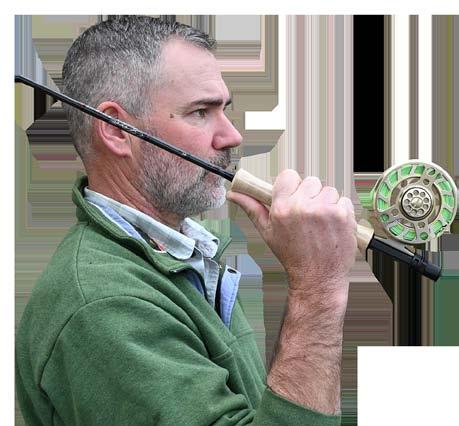
this grip and use it well. They have learned to maintain the angle of the rod during the casting stroke and use the fingers in the bottom of their hand to apply power in conjunction with pressure from their thumb therefore pulling the rod. However, this grip has limitations in the learning stages of fly casting. At the top of the stroke, this grip, like the previous one, will tend to have a rod angle that is two low without distorting the wrist to compensate. This grip, although commonly used, certainly has room for improvement.
THE LOOP, SPRING 2023
Grip continued ...
Finger-on-Top Grip
With the finger on top grip, your thumb is replaced with the index finger on the back of the rod. This grip has excellent control. We have been pointing our fingers at what we want since before we could all talk. This is an extremely accurate grip. It is a grip used by many that only fish for trout in small streams with small fly rods. Also, this grip solves an issue with the previous two grips because after the backcast, at the top of the stroke, the rod will have a much higher angle than the thumb-on-top and suitcase grips. The index finger, however, lacks the strength of the thumb, resulting in difficulty in handling high loads on the forward stroke. This is why you will rarely see saltwater anglers or distance casters use this grip. This grip is one that can be a stepping-stone to my preferred grip and one that I will have students use in the interim to help with a low back cast before trying to encourage them to use the extended-finger-grip.
Extended-Finger Grip
The extended-finger grip is a combination of the thumbon-top grip and the finger-on-top grips. I believe it is the most efficient grip to use for fly casting. To use this grip, simply place the rod across your palm at an angle extending from the fleshy part of your palm opposite your thumb to the knuckle of your index finger that connects the finger to the hand.



THE LOOP, SPRING 2023
Grip continued ...
Then close your hand around the rod so that your thumb extends up the side of the rod and your index finger extends up the opposite side and slightly curved around the front. The “V” between your thumb and index finger will be on the back or spine of the rod.
This grip is a little cumbersome to explain in writing, but it is very familiar to anyone who picks up a fly rod. This grip is akin to holding the key to your front door, and it is the same grip that you would use with a screwdriver. This is a very athletic grip, and we see it in several other sports. It is the shake hands grip in tennis and the bottom hand in golf. This grip will give us the best of both worlds as we have the accuracy of our index finger and the power of our thumb both extended up the rod. With two points of contact on this grip our true power will come from tightening the grip with our pinky and ring finger at the end of the forward stroke in conjunction with our stop. It negates the urge to push the rod over with the thumb. At the top of the stroke our rod remains in a high position promoting a good trajectory on the back cast. If we use this grip properly, we will have no awkward distortion in our wrist. We can cast with our wrist in a neutral position and rely on the more powerful muscles in our arm to make the cast. This grip has another advantage over the previous three because it allows the ability to easily cast off your opposite shoulder. Without changing the grip or distorting the wrist, simply turn your palm toward your forward cast. The rod will be over the opposite shoulder, which is far better than casting across your body or trying to use your backcast as a presentation cast.




THE LOOP, SPRING 2023
Grip
continued ...
I hope this article provides a little insight on how the grip can affect a cast. With new students, the advantages of the extended-finger grip are among the first things that I teach and include an evaluation of grip when diagnosing casting issues. The next time you look at a cast that is less than ideal, consider how simply altering the rod grip can help form the desired loop shape.

Chris King, MCI, THMCI, CBOG Emeritus - Redding, CA.
Chris was introduced to fly fishing at a young age. During his high school years in New Jersey he traveled the eastern seaboard in search of trout with his father. He spent 8 years in Colorado where he turned his passion into a career. From there he made his way West where in 1998 he found a home at The Fly Shop®.
Chris is currently Master Certified, Two Hand Master Certified and an emeritus member of the FFI Casting Board of Governors. Chris resides in Redding with his wife and two children and has been guiding and teaching casting in Northern California for over 20 years.
IF YOU ARE INTERESTED WITH THE FFI CASTING INSTRUCTOR CERTIFICATION PROGRAMS
Please click these following links for further information on: Casting Instructor Certification Program CI, MCI, THCI and THMCI study materials

Photos: Jim Wigington
HOW LEADERS WORK
Bruce Richards - The Loop Editorial StaffWe all use leaders, we all know about leaders, some of us even build our own leaders. But I have found in the process of mentoring many instructor candidates over the years that most do not understand leaders very well and that can hinder our work as casting instructors.
Leaders are pretty simple but there are a lot of variables to consider. A comprehensive article on leaders covering leaders from spring creek trout to tarpon would be much too long for The Loop. And much of the information would be of little interest to many readers. So what I’ll write about are leaders that are good for what all of us do, teach casting and maybe do fly casting demonstrations, with floating fly lines. These are also the leaders that work best for candidates taking the CI and MCI exams.
Leaders are functionally just an extension of our fly line. They have two functions, to distance the fly from the more visible fly line and dissipate the remaining energy of the cast so the fly is delivered as desired. Most leaders today are made of monofilament nylon whether they are the extruded, knotless variety that most of us buy or the knotted, hand tied leaders some of us still make. Either works just fine if designed and made properly. For this article I’m only going to consider extruded monofilament nylon leaders because they account for the vast majority of leaders used today. These leaders should be used both by an instructor and their students when they practice. They work very well and are relatively inexpensive. And these leaders
are not be radically different than the leaders we typically fish. For this article we will assume we are casting a typical good loop, approximately 3 ft. wide, relatively straight fly leg, moderate speed.
***Side note: I often hear anglers talk about their leader or tippet being made of either fluorocarbon or “mono”. “Mono” is short for monofilament, which simply means “single filament”. Both nylon and fluorocarbon leaders/tippet are monofilament. To be correct, we should specify that the material is either fluorocarbon or nylon, not “mono”.
LENGTH
The most common fishing leaders used today are 7.5-9 ft. long. That length range has been the most used length for decades. It was determined long ago that for most fly fishing applications leaders 7.5-9 ft. long worked best. Most fly lines are designed to cast those leaders. Leaders that are significantly shorter may not dissipate enough energy; longer leaders may dissipate too much. Of course, skilled casters can adjust their cast speed and efficiency (fly leg straightness) to make a wide variety of leaders work well.
Commercially available leaders must work for our students and typical buyers, who are average casters. Expert casters can make radical leader designs work, most others cannot.
For the exams I recommend a leader that is 8 ft. long. The exam requires that the leader be no shorter than 7.5 ft.
THE LOOP, SPRING 2023
How Leaders Work
continued ...
Using an 8 ft. leader allows a bit of length leeway should you break off a fly or two while testing. It is a good idea to have a spool of tippet with you, just in case you need to replace your tippet. Longer leaders do not offer an advantage.
TAPER
Fly lines are tapered and so are leaders, for the same reason. Fly lines have front tapers to reduce the mass of the end of the line. I won’t go into the physics here but reducing the mass of the front of the fly line dissipates the energy of the cast so that the leader and fly can deliver as desired. For teaching, testing or doing demos we don’t want a fly line that is too delicate or one that is too powerful. The same holds for the leader. Wind could be an issue and nerves probably will be. A leader that requires extra care when casting, because it is too delicate or too powerful, could be trouble. Loop shape (especially straightness of the fly leg) and speed have a big impact on how a line and leader will perform.
Leader formulas are typically written as three numbers, like 50/30/20. That means that 50% of the leaders length will be level butt section, 30% will be taper, and 20% will be level tippet. This profile makes a very good general purpose dry fly leader that throws yarn “flies” very nicely. Not too powerful, not too delicate, just right! Of course the butt and tip diameters need to be right, that will be covered later. On an 8 ft. leader a 50% level butt will maintain enough of the casts energy to insure a good turnover. A shorter butt would mean longer taper and/or tip and that would dissipate more energy so that the delivery would be less powerful, more delicate. A longer butt section would mean a shorter taper and/or tip which would preserve more energy and result in a more powerful turnover/delivery. If you tie your own leaders you can experiment with different profiles to see if you
might prefer something a bit different but I’ll bet what you prefer won’t be far from 50/30/20.
This assumes a leader length of 8-9 ft. As leaders get longer their profiles must change. Long leaders must have longer butt sections to maintain cast energy. A 16 ft. 50/30/20 leader will have an 8 ft. butt, a 58 in. taper and a 38 in. tippet. That taper and tippet is much too long and will dissipate too much energy and will be difficult to cast. A better formula for a leader that long would be 65/20/15. Just remember that leader formulas are length dependent, a profile that yields a perfect casting 7.5 ft. leader will not get the same results when used for a 12 ft. leader.
The top leader is a 9 ft. leader with 50/30/20 pro le.
The middle leader is a 12 ft. leader with the same taper and tippet, pro le is 63/23/14
The bottom leader is a 12 ft. leader with 50/30/20 pro le, not much longer taper/tippet sections.
I know there will be cries of “blasphemy” when I say this, but in over 55 years of fishing around the world I can’t think of a time when a leader longer than 12 ft. was necessary to fish effectively. Very long leaders dissipate a lot of energy, even if the butt section is very long.
How Leaders Work
continued ...
Remember, the butt section matches the tip of the fly line, the lightest, most delicate part of the line. We think leader butt sections are heavy, but they really aren’t. Very long leaders (more than 15 ft.) require loops with very straight fly legs AND a lot more line speed to cast with any accuracy. The vast majority of casters are not skilled enough to throw loops with very straight fly legs at high speed. Setting them up with leaders that require that is a recipe for failure.
BUTT
Fly lines work by transferring energy from one part of the line to the next as the loop propagates. This was discussed in detail in my previous article in The Loop (Fall 2022) on how loops work. When the loop propagates to the point that the fly line is transferring the remaining energy of the cast to the leader the leader needs to be designed so that transfer is smooth. For a smooth transfer the mass of the butt of the leader must match the mass of the tip of the fly line. If the leader butt is lighter than the line tip the leader won’t be able to take the energy smoothly, the excess energy will cause the line tip to kick and slack will be thrown into the leader. If the leader butt is too heavy the transition is also not as smooth as we’d like, but in over 45 years of teaching casting I’ve never had a student show up with a leader with a butt that was too big/heavy. Leader butts that are too light are very common.
So how do we know if our leader butt matches the line tip? First, an exact match isn’t necessary, but it should be close. One way to know is to cut a few inches off your line tip and the same length of leader butt. Weigh each on an accurate scale and compare. No, that is not convenient and will damage your line. We know the diameter of each line and we also know the approximate specific gravity, from that information we can compare. I won’t go into the math here but
the end result is that if you multiply the diameter of the tip of your floating fly line by 0.7 you will know what the diameter of the butt of your leader should be. A typical 6 weight floating fly line will have a tip diameter of about .036 in. Multiply that by 0.7 and you’ll find that the leader butt you attach to it should be about .025 in. The mass of the line tip will be the same as the mass of the leader butt and the energy transfer will be smooth. If the line tip was .040 in. the leader butt should be .028 in.
Of course you do need to know the diameter of each. Most manufacturers have diameter information on their websites. But when you’re teaching you often won’t have access to that. It is best to purchase an inexpensive digital micrometer and keep it in your teaching kit. You will use it more often than you think and it can solve casting problems you’d miss otherwise. With a micrometer you can confirm that the leader butt diameter is correct and you can quickly determine if the leader profile is appropriate. There are leaders made today with butts that are too small to work well and with some pretty weird profiles, but most are good.
In the past 20-30 years fly line tips have gotten larger and welded loops are now found on most fly line tips. Both of these changes have increased the mass of the tips of fly lines and that has also caused well designed leaders to have larger diameter butts. Of course, larger leader butts will transmit more energy so leader taper designs have also changed to dissipate more energy to insure the proper delivery, like 45/35/20 instead of 50/30/20. Keep this in mind if you tie your own leaders, especially if you follow older leader formulas. Most of them will specify leader butts that are significantly too light for good performance because they were developed years ago when line tips were smaller.
How Leaders Work
continued ...
If you tie your own leaders you definitely need a micrometer. I often hear leader profiles described as “4 ft. of 30 lb. monofilament, 2 ft. of 20 lb., 2 ft. of 15 lb., 2 ft. of 8 lb.” That’s all fine, but what diameter is the 30 lb. nylon monofilament being used? Tensile strength does not relate consistently to diameter and diameter is what we use to know the mass. The diameter of different 30 lb. monofilaments can vary greatly. One popular brand is .028 in. while another is .020 in. They are the same strength but very different mass. Making leaders based on line tensile strength will often yield disappointing results, especially if you mix brands. Do not rely on tensile strength of sections when making leaders. The only part of the leader where the tensile strength is important is the tippet. Measure the diameter of your fly line tip to determine what the butt diameter must be and work from there.
We often hear that leaders need stiff butts to cast well because it is leader stiffness that causes a leader to turn over well. If that was true we would all be using leaders that are very stiff and very small diameter (less wind resistant). But no one does that because it doesn’t work. Stiff leader butts will have a lot of memory and are very hard to straighten. Stiff monofilament, especially in larger sizes, is also hard to knot. The one advantage to stiff leader butts is when it is important that the leader butt lay very straight on the water. Once a stiff leader butt is straightened (which can be a chore) it will lay straight on the water a bit better than a limper leader butt of the same diameter, if that is important to you. Like fly lines, leaders work as they do because of their mass profile, not their stiffness. If stiffness was an important factor in leader casting performance it would be for fly lines too, but most fly lines are made to be quite limp.
TIPPET
For teaching/testing/demos there is no reason to use a light tippet.
With light tippets flies will break off frequently and if there is wind deliveries will be less consistent. I typically use Scientific Anglers 8 ft. Bass leaders with 10-12 lb. test tippets on 6 or 7 wt. lines. The butts are big, taper aggressive and the tippets are tough. If I do need a bit less punch I’ll just extend the tippet another 12 in. For these applications it doesn’t matter much what tippet material you use but softer, more flexible monofilament is easier to knot and straighten. Just make sure that whatever tippet you add to a leader it is the same or smaller diameter than what you are tying it too.
Of course, for fishing, the fly fishing application and conditions will often require different leader parameters than we would use for teaching/testing/demonstrating. But the theory is the same. Determine the right butt diameter. Then decide how long your leader needs to be and determine an appropriate profile and tippet. Leaders are really quite simple once it is understood how they work!
Bruce Richards, MCI, Montana, USA, Bruce is a member of The Loop editorial team. About the author:

CBOG Continuing Education Report:
TRIANGLE TEACHING TECHNIQUE
by Lee CummingsReport by Chuck Iossi, CI, ‘The Loop’ Associate Editor
Introduction
Gail Donaghue, Casting Board of Governors, hosted a Continuing Education Zoom Feb 18, 2023 session “The Triangle Method with Lee Cummings.” Astonishingly, an enthusiastic 106 FFI members participated in the virtual seminar. Given the level of interest, The Loop Journal staff would like to provide readers the opportunity to revisit the CE class. Also, Thanks to Lee Cummings for his review of this article.
Setting the Stage
How do you start your casting instruction with a beginner? Pick up and lay down? Grass drills? Would you like an alternative approach used successfully by a well known caster and instructor in Great Britain and a record holder in both distance and accuracy casting competition events? But more important than that, he is a superb instructor who has devised a method for teaching beginners how to form good loops in just a few minutes without the struggles that beginners often encounter.
Acquisition
In the presentation Lee Cummings explained how to use his triangle teaching technique to teach beginners to false cast in just a few minutes and how the technique can be used with equal success
to teach just about any fly cast. Many instructors have asked for another method to teach the pick up and lay down to help beginning students avoid the common errors that can be so daunting. The Lee Cummings Triangle Teaching Technique is standard practice in Great Britain. If you are a member of the FFI Casting Instructor Certification Program (CICP), you still have a chance to see Lee on the archived video session and learn how to add his powerfully effective teaching method to your repertoire. Instructions for accessing this video are provided at the end of this article. Lee incorporates his YouTube video in the seminar, so you may want direct access:

THE LOOP, SPRING 2023
Triangle Teaching Technique
continued ...
Explanation
1. Lee was adamant about knowing the head length used with students. He prescribes a 30’ head, e.g. Rio “Outbound” line or similar product https://farbank.com/products/rio-premier-outbound-short
2. The “triangle” is formed with 30’ of rope and three pegs to hold the corners (tent pegs or gardener’s staples). He uses five cones, three for the corners and two for shorter rod stroke markers at the outset. Be sure to configure a 90º angle at the caster’s feet.
3. It is critical to set up the triangle with wind at the student’s back or it will not work due to uneven wind effect on the line. The student position will allow him/her to see the forward and back cast.
Structured Practice
1. Have the student get the feel of rod and line by lifting the rod to a 45º angle from the ground and imagining the cones are now lifted into the air at that angle above the ground.
2. The student creates short strokes between the two internal cones without creating loops making a straight line with the rod tip.
3. The distance increases marginally by moving the internal cones closer to the corner cones, again without forming loops but adding a pause. The student concentrates on moving the rod tip in a straight line.
4. Next the student moves the rod tip in a straight line from one imaginary elevated corner of the triangle to the other increasing the pause at each corner. The line leaves the ground and is cast back and forth with minimum effort. The student should feel the weight of the line under tension as they control the line effortlessly.
5. Practicing the false cast prepares the student for the next levels of casting.
Now make a Visual Instruction Plan and take it outdoors!

Chuck Iossi, CI - Teton Valley, ID
Chuck is a member of The Loop editorial team
HOW TO ACCESS CONTINUING EDUCATION INSTRUCTOR RESOURCES
The author presented a FFI Casting Continuing Education program on this topic. Certified Instructors with the Casting Instructor Certification Program (CICP) can access a video recording of this program using the following instructions.
1. Login to your FFI account*
2. Select “Get Involved” tab and under
3. “Casting Instructor Certification” select “CICP Resources and CE”
4. Under “Instructor Resources-Continuing Education” select “CE Recordings”
5. Scroll down to the appropriate video and use the password above the video link(“CastingisAwesome!”)
*If you have not accessed the FFI website since the February 2023 update, click the “Reset Password” button before attempting to log-in.
THE LOOP, SPRING 2023
NEW REGISTERED INSTRUCTORS
Newly Certified Instructors listed according to test date.
For incoming test date and other CICP events information, please visit: http://flyfishersinternational.org/Casting/CalendarofEvents/tabid/616/Default.aspx
The Editorial Team

Jim Wigington, MCI, Editor-inChief, Redding, California USA. Jim is a retired research hydrologist who spent his career evaluating the effects of human activities on watersheds and streams.
He has published in many scientific journals and previously was Editor-in-Chief of the Journal of the American Water Resources Association. Currently, Jim is an active casting instructor and L-1 examiner.

Mac Brown, MCI, is the owner of Mac Brown Fly Fish and Fly Fishing Guide School in Bryson City, NC. He is the author of Casting Angles and contributor to numerous magazine articles.
Mac will serve as a technical advisor for the Loop. He enjoys adventure travel with his family when not teaching fly fishing techniques.

Bruce Richards, MCI, Montana, USA, designed many great lines for Scientific Anglers and wrote the seminal work, Modern Fly Lines.
He is a former chair of CBOG and was instrumental in the development of the Casting Instructors’ Certification Program (CICP).

Paul Brown, MCI, THMCI & L-1 Examiner, England. Paul is also a member of the UK’s Game Angling Instructors’ Association (GAIA) and holds the Advanced Professional Game Angling Instructors’ qualification (APGAI) in both doublehanded and single-handed and is also a qualified GAIA Mentor and Assessor.
Paul is a published author of children’ books, he also has 30 years media experience with some of the best ad agencies in England.
The Editorial Team
INTRODUCING OUR NEW ASSOCIATE EDITOR
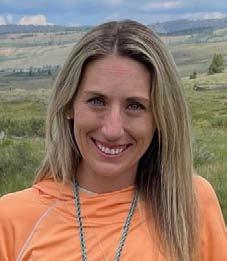
Audrey Wilson, CI
Audrey’s fly-fishing journey began more than 15 years ago. She has always loved and appreciated sports and the outdoors. Like many who were intrigued with the movie, A River Runs Through It, her intrigue began at the age of eight when the movie came out. Later in life, she had the opportunity to begin learning the sport on the Green River below Flaming Gorge Dam. Although she loves to fish, she quickly gained an appreciation and passion for the cast. Soon thereafter, Audrey began working with FFI mentors while at the same time following her passion to compete and test her skills through tournament casting. Audrey is now the founder of her business, At First Cast. She’s also a two-time bronze medalist at the 2022 World Flycasting Championship, and a top civilian leader in the Air Force. Audrey enjoys sharing her passions for fly-casting, fishing, and leadership to teach and coach others. She’s the first female to become a Certified Instructor (CI) in Utah. She also loves to donate her time to organizations like FFI, and Casting for Recovery (CfR). Audrey served and led the Utah Chapter of CfR for several years. She’s also contributed to numerous editorials and blogs and looks forward to contributing to The Loop!

Chuck Iossi, CI, Teton Valley, ID is a retired academic publishing executive of university level textbooks and library reference material.
His last assignment was CEO of Thomson Reuters Academic in London, UK. He is a Board of Directors President Emeritus, Friends of the Teton River, and is also a member of Trout Unlimited and FFI.

Bintoro Tedjosiswoyo is a CI & THMCI who lives in Melbourne, Australia. He is the first FFI certified THCI/THMCI in the Southern Hemisphere.
Bintoro is a commercial graphic designer and illustrator, he is The Loop’s graphic design editor and illustrator.
All correspondence to be addressed to: loop@flyfishersinternational.org - Website: http://flyfishersinternational.org/ Copyright © 2023, Fly Fishers International (FFI) The Loop and the individual contributors. All materials contained in this publication are protected by United States copyright law and may not be reproduced, distributed, transmitted, displayed, published or broadcast without the prior written permission The Loop and the author or contributor of that content. However, you may download material from The Loop for your personal, noncommercial use only. Links to Web sites other than those owned by the FFI are offered as a service to readers. Neither the FFI nor the editorial staff of The Loop was involved in their production and they are not responsible for their content.
